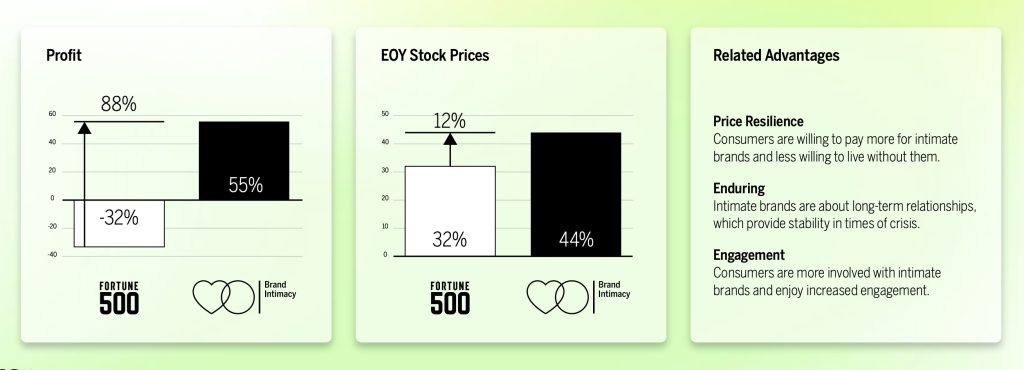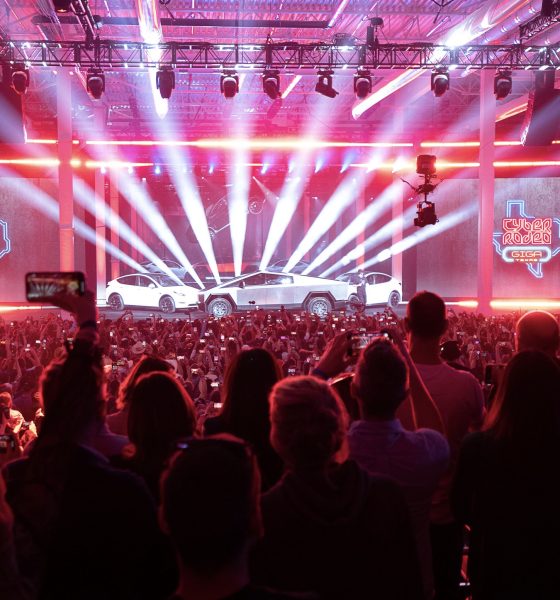Tesla scored a high brand intimacy rating in the MBLM 2022 report. MBLM researched 600 of the world’s leading brands, and Tesla placed second, right behind Disney.
Tesla scored a 67.4 brand intimacy rating, closing following Disney’s score of 68.1. The Elon Musk-led EV maker was the highest-ranking automotive brand in MBLM’s 2022 report. Mercedes-Benz received a score of 63.9, placing sixth on the list. The German brand is the only other automaker in the top ten.
Porsche, Jaguar, and Mazda received the next highest scores among automakers. With a score of 58.4 Porsche was in 12th place, followed by Jaguar in 13th place, which received the same score. Mazda was 15th on the list, scoring a brand intimacy rating of 57.5.

What is Brand Intimacy?
Brand intimacy is a marketing strategy that has gained a strong foothold in multiple industries. It measures the relationship brands build with their customers to establish trust and gain brand loyalty. Brand intimacy is usually measured through the emotional connection brands create with their customers.
Advantages of Brand Intimacy
According to MBLM’s 2022 report, consumers’ emotional relationships with brands have increased by 9% since before COVID. Brand performance has also increased by 19% since the pandemic, hinting that consumers are building deeper relationships with brands.
“Intimate brands continue to outperform Fortune 500 and the stock market,” stated MBLM.

“Intimate brands delivered superior results across profit and stock. The percentage differences highlighted are significant and indicate the degree to which intimate brands generate millions more dollars in revenue and profit annually and over the long term.”
Tesla’s brand Intimacy
Tesla was a new entry in MBLM’s brand intimacy report. The results revealed that Tesla consumers have a strong emotional attachment to the car brand.
The main keywords Tesla is associated with are very telling: “impressive,” “badass,” and “crypto.” Crypto might seem out of place to a Tesla outsider. However, Elon Musk has been vocal about his thoughts on cryptocurrencies. Dogecoin, in particular, has become somewhat of an inside joke among Tesla investors and users.

Elon Musk has heavily contributed to Tesla’s strong brand intimacy, specifically through his tweets on Twitter and active presence in the community surrounding the brand. Musk has agreed to interviews with YouTubers, influencers, and other prominent members of the Tesla community, making him a more down-to-earth CEO compared to others in the tech industry.
Elon Musk tends to elicit strong emotions from both sides of the Tesla sphere. Tesla bulls usually show strong support for the company, while Tesla bears often voice their vehement dislike for the company and its CEO. The media has also treaded both sides of the Tesla sphere, contributing to its prominence. Tesla’s adversaries have likely helped increase the brand’s intimacy rating, as supporters often rally against them.
I’d like to hear from you. Contact me at maria@teslarati.com or via Twitter @Writer_01001101.

News
Tesla starts showing how FSD will change lives in Europe
Local officials tested the system on narrow country roads and were impressed by FSD’s smooth, human-like driving, with some calling the service a game-changer for everyday life in areas that are far from urban centers.

Tesla has launched Europe’s first public shuttle service using Full Self-Driving (Supervised) in the rural Eifelkreis Bitburg-Prüm region of Germany, demonstrating how the technology can restore independence and mobility for people who struggle with limited transport options.
Local officials tested the system on narrow country roads and were impressed by FSD’s smooth, human-like driving, with some calling the service a game-changer for everyday life in areas that are far from urban centers.
Officials see real impact on rural residents
Arzfeld Mayor Johannes Kuhl and District Administrator Andreas Kruppert personally tested the Tesla shuttle service. This allowed them to see just how well FSD navigated winding lanes and rural roads confidently. Kruppert said, “Autonomous driving sounds like science fiction to many, but we simply see here that it works totally well in rural regions too.” Kuhl, for his part, also noted that FSD “feels like a very experienced driver.”
The pilot complements the area’s “Citizen Bus” program, which provides on-demand rides for elderly residents who can no longer drive themselves. Tesla Europe shared a video of a demonstration of the service, highlighting how FSD gives people their freedom back, even in places where public transport is not as prevalent.
What the Ministry for Economic Affairs and Transport says
Rhineland-Palatinate’s Minister Daniela Schmitt supported the project, praising the collaboration that made this “first of its kind in Europe” possible. As per the ministry, the rural rollout for the service shows FSD’s potential beyond major cities, and it delivers tangible benefits like grocery runs, doctor visits, and social connections for isolated residents.
“Reliable and flexible mobility is especially vital in rural areas. With the launch of a shuttle service using self-driving vehicles (FSD supervised) by Tesla in the Eifelkreis Bitburg-Prüm, an innovative pilot project is now getting underway that complements local community bus services. It is the first project of its kind in Europe.
“The result is a real gain for rural mobility: greater accessibility, more flexibility and tangible benefits for everyday life. A strong signal for innovation, cooperation and future-oriented mobility beyond urban centers,” the ministry wrote in a LinkedIn post.
News
Tesla China quietly posts Robotaxi-related job listing
Tesla China is currently seeking a Low Voltage Electrical Engineer to work on circuit board design for the company’s autonomous vehicles.

Tesla has posted a new job listing in Shanghai explicitly tied to its Robotaxi program, fueling speculation that the company is preparing to launch its dedicated autonomous ride-hailing service in China.
As noted in the listing, Tesla China is currently seeking a Low Voltage Electrical Engineer to work on circuit board design for the company’s autonomous vehicles.
Robotaxi-specific role
The listing, which was shared on social media platform X by industry watcher @tslaming, suggested that Tesla China is looking to fill the role urgently. The job listing itself specifically mentions that the person hired for the role will be working on the Low Voltage Hardware team, which would design the circuit boards that would serve as the nervous system of the Robotaxi.
Key tasks for the role, as indicated in the job listing, include collaboration with PCB layout, firmware, mechanical, program management, and validation teams, among other responsibilities. The role is based in Shanghai.
China Robotaxi launch
China represents a massive potential market for robotaxis, with its dense urban centers and supportive policies in select cities. Tesla has limited permission to roll out FSD in the country, though despite this, its vehicles have been hailed as among the best in the market when it comes to autonomous features. So far, at least, it appears that China supports Tesla’s FSD and Robotaxi rollout.
This was hinted at in November, when Tesla brought the Cybercab to the 8th China International Import Expo (CIIE) in Shanghai, marking the first time that the autonomous two-seater was brought to the Asia-Pacific region. The vehicle, despite not having a release date in China, received a significant amount of interest among the event’s attendees.
Elon Musk
Elon Musk and Tesla AI Director share insights after empty driver seat Robotaxi rides
The executives’ unoccupied tests hint at the rapid progress of Tesla’s unsupervised Robotaxi efforts.

Tesla CEO Elon Musk and AI Director Ashok Elluswamy celebrated Christmas Eve by sharing personal experiences with Robotaxi vehicles that had no safety monitor or occupant in the driver’s seat. Musk described the system’s “perfect driving” around Austin, while Elluswamy posted video from the back seat, calling it “an amazing experience.”
The executives’ unoccupied tests hint at the rapid progress of Tesla’s unsupervised Robotaxi efforts.
Elon and Ashok’s firsthand Robotaxi insights
Prior to Musk and the Tesla AI Director’s posts, sightings of unmanned Teslas navigating public roads were widely shared on social media. One such vehicle was spotted in Austin, Texas, which Elon Musk acknowleged by stating that “Testing is underway with no occupants in the car.”
Based on his Christmas Eve post, Musk seemed to have tested an unmanned Tesla himself. “A Tesla with no safety monitor in the car and me sitting in the passenger seat took me all around Austin on Sunday with perfect driving,” Musk wrote in his post.
Elluswamy responded with a 2-minute video showing himself in the rear of an unmanned Tesla. The video featured the vehicle’s empty front seats, as well as its smooth handling through real-world traffic. He captioned his video with the words, “It’s an amazing experience!”
Towards Unsupervised operations
During an xAI Hackathon earlier this month, Elon Musk mentioned that Tesla owed be removing Safety Monitors from its Robotaxis in Austin in just three weeks. “Unsupervised is pretty much solved at this point. So there will be Tesla Robotaxis operating in Austin with no one in them. Not even anyone in the passenger seat in about three weeks,” he said. Musk echoed similar estimates at the 2025 Annual Shareholder Meeting and the Q3 2025 earnings call.
Considering the insights that were posted Musk and Elluswamy, it does appear that Tesla is working hard towards operating its Robotaxis with no safety monitors. This is quite impressive considering that the service was launched just earlier this year.










